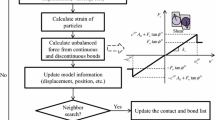Abstract
In order to analyze the sensitivity of bending and toppling deformation of anti-dip slopes on the selected impact factors, numerical simulation is conducted and combined with grey relation analysis. Physical geometry, physical and mechanical properties of rock, and mechanical characteristics of joints are adopted as the first-grade impact factors on bending and toppling deformation; and they are further subdivided into second-grade factors of slope angle, strata dip, rock flexibility, etc. In the numerical simulation, eleven different levels of values are assumed for each of those impact factors, and eleven sets of numerical schemes are established randomly, then UDEC is used to perform the simulation for each case. Finally, by applying the grey relation analysis, the correlation of each impact factor (both first- and second-grade) on bending and toppling deformation are calculated. The results indicate that: (1) the correlation of the 12 s-grade impact factors on bending and toppling deformation are, in a descending order: strata dip > slope angle > kn/ks > Poisson’s ratio > Friction of joints > friction of rock mass > tensile strength of rock mass > flexibility > cohesion of rock > elastic modulus > cohesion of joints > density. (2) Among first-grade impact factors, the physical geometry has the greatest impact on the bending and toppling deformation of the anti-dip slope, and it is followed by mechanical parameters of joints, while the physical and mechanical parameters of rock are found to have the minimal influence.



Similar content being viewed by others
References
Adhikary DP, Dyskin AV (2007) Modeling of progressive and instantaneous failures of foliated rock slopes. Rock Mech Rock Eng 40(4):349–362
Baocheng Z, Congxin C, Xiaowei L et al (2005) Modeling experiment study on failure mechanism of counter-tilt rock slope. Chinese J Rock Mech Eng 19:107–113
Beichuan H, Sijing W (1999) Mechanism for toppling deformation of slope and analysis of influencing factors on it [J]. J Eng Geol 03:213–217
Cheng DX, Liu DA, Ding EB, et al. (2005) Analysis on influential factors and toppling conditions of toppling rock slope [J]. Chinese J Geotech Eng. 27(11):127–131
Deng J (2008) Grey Theory [M]. Huazhong University of Science & Technology Press, pp 135–141
Guangming R, Dexin N, Gao L (2003) Studies on deformation and failure properties of anti-dip rockmass slope. Chinese Rock Mech Eng 22(S2):2707–2710
Huang R, Wang Z, Xu Q (1994) A research of the deformation and the failure of anti-dip rock slope [C]. Southwest Jiaotong University Press, Chengdu, pp 62–73
Huayang L, Jing W, Xinyu X et al (2000) Displacement monitoring and deformation characteristics of ship lock slope at left bank of wuqiangxi hydropower station. Dam Observ Geotech Tests 24(3):22–24
Lifang Z, Weiya X, Yu N et al (2009) Overview of toppling failure mechanism of countertendency layered rock slopes. J Yangtze River Scient Res Inst 05:25–30
Peihua X, Jianping C, Runqiu H, et al (2004) Deformation mechanism of Jiefanggou high steep dipslope in jinping hydropower station J Eng Geol (03):247–252
Rujiao T, Xuzhao Y, Ruilin H (2009) Review of deformation mechanism and stability analysis of anti-dipped rock slopes. Rock Soil Mech 30(S2):479–484
Shiliang S (1999) Theory analysis of interzone of distinguishing coefficient in grey interrelated model and practical validation in safety valuation of working faces. Xiangtan Min Inst 14(2):7–11
Sjöberg J (1999) Analysis of failure mechanisms in high rock slopes[C]//In: Gerard Vouille, Pierre Berest Proceeding of the Ninth International Congress on Rock Mechanics. Paris, Taylor and Francis Group, pp 127–130
Xiaogang W, Zhixin JIA, Zuyu C (1996) The research of stability analysis of toppling failure of jointed rock slope [J]. Shuili Xuebao 18(03):7–12
Xiaogang W, Jianhong Z, Yuzhi Z (1996) Investigations on mechanism of slope toppling failure by centrifuge model testing. (05):18–25
Xijie Y, Echuan Y, Zhaolai S (2007) Slip surface ascertaining and stability analyzing of the countertendency shale slope. Rock Soil Mech S1:595–598
Yue C, Yasuhiro M, Tetsuro E (2008) Numerical analysis of stability for an anti-dip stratified rock slope. Chinese J Rock Mech Eng (12):2517–2522
Yunpeng L, Hui D, Runqiu H, et al (2012) Numerical simulation of seismic response of anti-dumping rock slope inter bedded by hard and soft layers. Hydrogeol Eng Geol (03):30–37
Zhang ZY, Wang LS, Wang ST et al (1993) Analytical principle of engineering geology. Geological Press, Beijing, pp 315–355
Zuyu C, Jianhong Z, Xiaogang W (1996) A simplified method of dumping stability analysis for rock slope. Chinese J Geotech Eng 06:96–99
Acknowledgments
This project was supported by the National Program on Key Basic Research Project (973 Program) (No. 2011CB710605).
Author information
Authors and Affiliations
Corresponding author
Rights and permissions
About this article
Cite this article
Xie, L., Yan, E., Ren, X. et al. Sensitivity Analysis of Bending and Toppling Deformation for Anti-slope Based on the Grey Relation Method. Geotech Geol Eng 33, 35–41 (2015). https://doi.org/10.1007/s10706-014-9817-9
Received:
Accepted:
Published:
Issue Date:
DOI: https://doi.org/10.1007/s10706-014-9817-9




